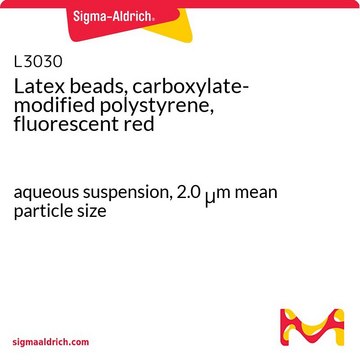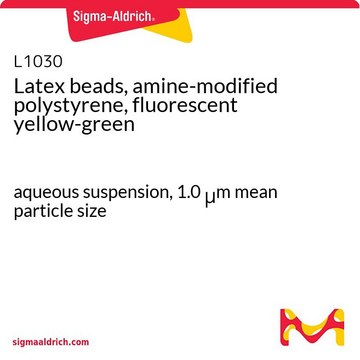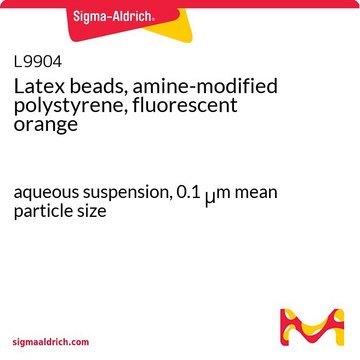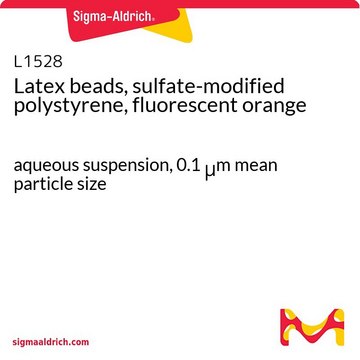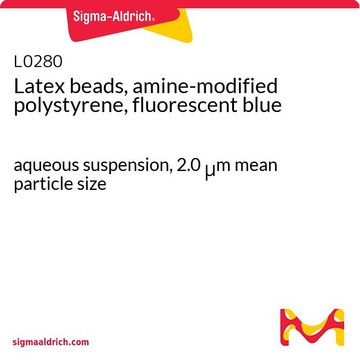L3280
Latex beads, carboxylate-modified polystyrene, fluorescent red
aqueous suspension, 0.5 μm mean particle size
Sinonimo/i:
Carboxylate Polystyrene Beads, Fluorescent Latex Beads
Autenticatiper visualizzare i prezzi riservati alla tua organizzazione & contrattuali
About This Item
Prodotti consigliati
Stato
aqueous suspension
Livello qualitativo
Composizione
Solids, 2.5%
tecniche
cell based assay: suitable
Dimens. media particelle
0.5 μm
Fluorescenza
λex ~575 nm; λem ~610 nm
applicazioni
cell analysis
Cerchi prodotti simili? Visita Guida al confronto tra prodotti
Applicazioni
Carboxylate-modified polystyrene latex beads have been used to collect morphofunctional data about the immune systems of Carabus lefebvrei, a helicophagous Italian endemic ground beetle often used as an indicator of the habitat quality of the Apennines mountain forests. Carboxylate-modified polystyrene latex beads have also been used to inform comparative studies on immunity defense mechanisms of adults and larvae of the coleopteran Cetonischema aeruginosa and to investigate the phagocytic activity of cultured rat thyroid cells.
Latex beads, carboxylate-modified polystyrene, fluorescent red has been used:
- along with Milli-Q for fluid dynamic studies
- along with bile salts for confocal studies
- for particle encapsulation
Codice della classe di stoccaggio
10 - Combustible liquids
Classe di pericolosità dell'acqua (WGK)
WGK 3
Punto d’infiammabilità (°F)
Not applicable
Punto d’infiammabilità (°C)
Not applicable
Dispositivi di protezione individuale
Eyeshields, Gloves
Scegli una delle versioni più recenti:
Possiedi già questo prodotto?
I documenti relativi ai prodotti acquistati recentemente sono disponibili nell’Archivio dei documenti.
I clienti hanno visto anche
Daeho Choi et al.
Soft matter, 15(23), 4647-4655 (2019-05-11)
Passive droplet generation for an aqueous two-phase system (ATPS) was performed with a fracture-based variable microchannel. A jet of dextran-rich phase (DEX) in a polyethylene-glycol (PEG)-rich phase was created by focused flow. The width of the inlet channel could be
Adam Macierzanka et al.
PloS one, 9(4), e95274-e95274 (2014-04-24)
The final boundary between digested food and the cells that take up nutrients in the small intestine is a protective layer of mucus. In this work, the microstructural organization and permeability of the intestinal mucus have been determined under conditions
Fumihiko Kitagawa et al.
Journal of chromatography. A, 1106(1-2), 36-42 (2006-01-31)
This paper reports a thermal lens microscope (TLM) detection coupled with capillary electrophoresis (CE) by using an interface chip (IFChip) to achieve highly sensitive detection with high reproducibility. Fused silica capillaries with an inner diameter of 50 microm were directly
Kristen M Flatt et al.
Genetics, 211(1), 169-183 (2018-11-10)
Phenotypic plasticity is a critical component of an organism's ability to thrive in a changing environment. The free-living nematode Caenorhabditis elegans adapts to unfavorable environmental conditions by pausing reproductive development and entering a stress-resistant larval stage known as dauer. The
Passive droplet generation in aqueous two-phase systems with a variable-width microchannel
Choi D, et al.
Soft Matter, 15(23), 4647-4655 (2019)
Il team dei nostri ricercatori vanta grande esperienza in tutte le aree della ricerca quali Life Science, scienza dei materiali, sintesi chimica, cromatografia, discipline analitiche, ecc..
Contatta l'Assistenza Tecnica.
